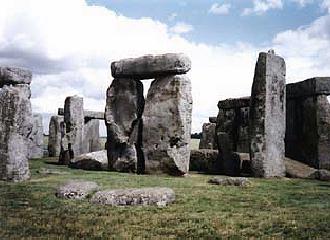 |
 |

Stonehenge
[Monday - 10/31/94] Stonehenge is, without doubt, the monument most famously associated with Britain the world over, and is unequalled anywhere else in the prehistoric world. For us, it was a mandatory stop despite brooding weather.
The construction of this massive stone circle spans a period from 3050BC to 1600BC, and was built in three distinct phases. Firstly, a circular bank and ditch with an inner circle of holes, called ‘Aubury holes’ (approximately 1m wide), was created - the holes, cut into the chalk, are believed to have contained timber posts originally. There were two entrances to the circle, one in the north east being the main entrance which aligns with the Midsummer sunrise, and a smaller one to the south.
Phase two saw the introduction of many timber posts, randomly placed within the inner circle. These may have supported roofed structures but due to the haphazard siting of these posts, it has proved difficult for archaeologists to ascertain their true usage. The outer ditch had gradually filled and, along with the Aubury Holes, was used for cremational burials.
The final, and most spectacular, phase started around 2600BC when the first large stones were placed. Initially these comprised of a double crescent of some 60 Blue stones, each weighing 4 tons, which were somehow transported from the Preseli Mountain in Wales. Presumably, this was achieved by land and sea, a distance of approximately 240 miles (385km) which, even by today’s standards, would be a considerable feat, but 4600 years ago is nothing short of astonishing.
After several hundred years this crescent was dismantled as the next stage of the stone construction began with the erection of the gigantic Sarsen stones, which can still be seen today. The Sarsen stones were transported from nearby Marlborough (some 20 miles (30km) to the North), each one weighing some 25 tons. It is calculated that it would have taken 600 men nearly a year to move each stone to its current position by manpower alone.
The first stones to be raised formed a horseshoe shape, comprising five huge Trilithons each made up of two uprights with a lintel stone on top. These were then surrounded by a circle of 30 uprights, capped with a continuous row of shaped lintels.
Considering the primitive tools of the time, the complexity of this construction is quite remarkable, inasmuch as all of the stones had been dressed and squared prior to their erection. The lintels were fixed tight to the top of the uprights using mortise and tenon joints actually worked into the stone, with the lintels being further locked into place, end to end, with tongue and groove joints. Not only were all these high precision joints used, but the lintels were also worked into curves so that a circular overall shape could be formed.
With the challenges of transportation, working the stones, and erecting a monument on such a huge scale, Stonehenge is indeed a testament to the skill of its builders. Even the sheer physical effort involved in the construction shows what an important site this must have been for the ancient peoples.
Today, as a listed World Heritage site, this great mysterious structure, attracts droves of people of all year round, and still retains a certain magnetism for the modern Druids who make their annual pilgrimage to the Salisbury Plains every June 24th for the Midsummer Solstice. We were treated to several unusual and spectacular events while there ourselves. First, an amazingly brief, but brutal thunderstorm has us scrambling for the tunnels. But the clearest and most stunning double rainbow we've ever seen, was more than ample reward.
|
Last modified on Wednesday, November 26, 2008 URL: http://www.housecorvus.org/sth.htm Copyright © 2000-09 House Corvus. All rights reserved. Design and hosting by Bran Trefonnen. | |